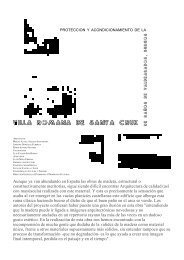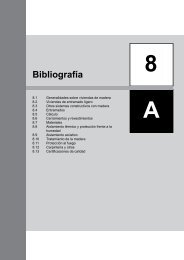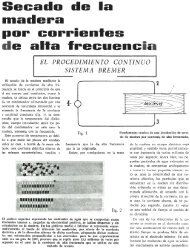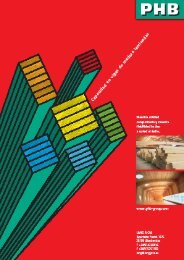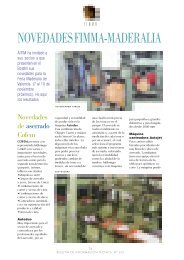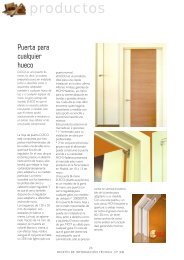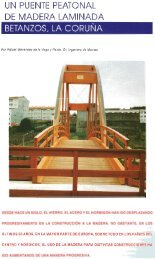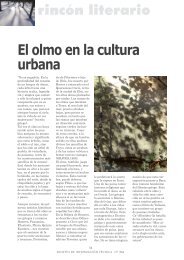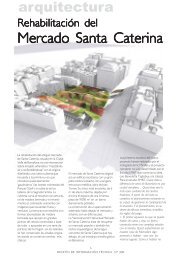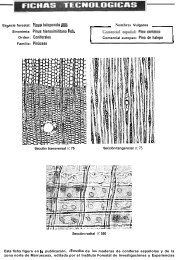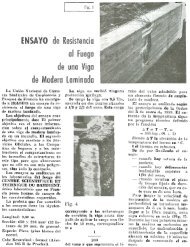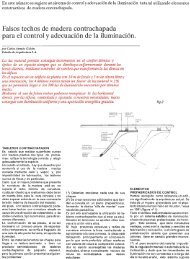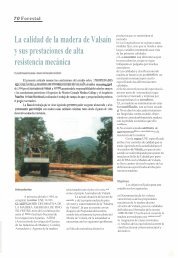Tratados e historia de la construcción en Finlandia - Aitim
Tratados e historia de la construcción en Finlandia - Aitim
Tratados e historia de la construcción en Finlandia - Aitim
Create successful ePaper yourself
Turn your PDF publications into a flip-book with our unique Google optimized e-Paper software.
ARQUITECTURA<br />
mucho a <strong>la</strong> Unión Soviética<br />
como comp<strong>en</strong>saciones <strong>de</strong><br />
guerra.<br />
Las típicas casas <strong>de</strong> los años '60<br />
y '70 manifestaban, sin embargo,<br />
una cierta sospecha hacia <strong>la</strong><br />
ma<strong>de</strong>ra <strong>en</strong> fachadas por su<br />
necesidad <strong>de</strong> mant<strong>en</strong>imi<strong>en</strong>to.<br />
Para solucionar este problema<br />
se recurrió al asbesto como<br />
material libre <strong>de</strong> mant<strong>en</strong>imi<strong>en</strong>to,<br />
al <strong>la</strong>drillo y a <strong>la</strong>s p<strong>la</strong>nchas<br />
metálicas, pero fue finalm<strong>en</strong>te el<br />
tablero <strong>de</strong> partícu<strong>la</strong>s el que se<br />
impuso, revestido con productos<br />
al látex.<br />
A <strong>la</strong> manta ais<strong>la</strong>nte <strong>de</strong> 100-150<br />
mm se empezó a añadir una<br />
lámina <strong>de</strong> plástico como barrera<br />
<strong>de</strong> vapor.<br />
La industria <strong>de</strong> fabricación <strong>de</strong><br />
vivi<strong>en</strong>das <strong>de</strong> pequeña dim<strong>en</strong>sión<br />
se impuso finalm<strong>en</strong>te gracias a<br />
<strong>la</strong> crisis <strong>de</strong> <strong>la</strong> <strong>en</strong>ergía, <strong>la</strong> búsqueda<br />
<strong>de</strong> materiales respirantes, el<br />
miedo a <strong>la</strong>s radiaciones <strong>de</strong><br />
radón y el s<strong>en</strong>tido ecológico <strong>de</strong><br />
los materiales.<br />
the same speed.<br />
Easy of transportation has always be<strong>en</strong> part of the<br />
nature of the woo<strong>de</strong>n house, compared to masonry<br />
or frame-built structures. Log buildings were hw<strong>en</strong><br />
in <strong>la</strong>te winter in the forest or ev<strong>en</strong> on the ice,<br />
dismantled and brought into the courtyard or sold<br />
to the town. The numbering found on building<br />
timbers does not, therefore, necessarily refer to<br />
anything more than transportation during<br />
building. This Nordic custom was won<strong>de</strong>red at by<br />
travellers as early as the 16th c<strong>en</strong>tury. The moving<br />
of buildings p<strong>la</strong>yed a major role in divisions of<br />
<strong>la</strong>nds. Materials used were corrugated iron, cart<br />
iron and wood. In the 1890s, a few carp<strong>en</strong>try<br />
factories began to produces small prefabricated cold<br />
buildings such as bathing rooms and<br />
summerhouses. Houses and vil<strong>la</strong>s were<br />
manufactured in 1928, in Helsinki and Jaakkima,<br />
and Ahllström p<strong>la</strong>nned a real factory for woo<strong>de</strong>n<br />
houses at the <strong>en</strong>d of the 1930s. The final impetus<br />
for the Finnish prefabricated house industry was<br />
giv<strong>en</strong> by the Winter War and its requirem<strong>en</strong> for<br />
barracks. During the intermediate peace of 1940,<br />
the company Puutalo Oy was foun<strong>de</strong>d through the<br />
joint efforts of 21 timber firms. A great <strong>de</strong>al of<br />
help was received from Swe<strong>de</strong>n, where the<br />
production of prefabricated houses was already<br />
flourishing in the 1930. More than one thousand<br />
type-p<strong>la</strong>ns were drawn up in the first t<strong>en</strong> years.<br />
War reparations provi<strong>de</strong>d the basis for export to<br />
the soviet Union, which <strong>la</strong>ter became significatn.<br />
In 1950 Puutalo Oy had become the world´s <strong>la</strong>rgest<br />
exporter of prefabricated woo<strong>de</strong>n buildings.<br />
Typical of the woo<strong>de</strong>n houses of the 1960s, and<br />
1970s was a faint suspicion of wood as a material<br />
for faça<strong>de</strong>s - this was caused at leats in part by the<br />
problems in maint<strong>en</strong>ance painting caused by <strong>la</strong>tex.<br />
The abestos elem<strong>en</strong>t panel Minerite was advertised<br />
expressly as a ‘maint<strong>en</strong>ance-free`solution, brich<br />
c<strong>la</strong>dding became more common and sheet metal,<br />
too, ma<strong>de</strong> its appearance. It was obvious that 100-<br />
150mm mineral wool, with a p<strong>la</strong>stic film as<br />
moisture barrier should be used as insu<strong>la</strong>tion.<br />
Op<strong>en</strong>-seamed chipboard rolled with <strong>la</strong>tex was the<br />
commonest surface material. A sloping roof was<br />
supported with <strong>la</strong>ttice structures and <strong>la</strong>minated<br />
timber, too, was employed. The industrial building<br />
of small houses with their differ<strong>en</strong>t house packages,<br />
which had begun in the 1940s, now conquered the<br />
markets. It was this situation which th<strong>en</strong> ran into<br />
the <strong>en</strong>ergy crtisis, formal<strong>de</strong>hy<strong>de</strong> emissions, the<br />
radon problem, breathing buildings, dry rot, the<br />
removal of asbestos, natural paints, fungal<br />
damage and ecological thinking about materials.<br />
36<br />
BOLETÍN DE INFORMACIÓN TÉCNICA Nº 196



